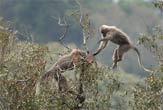
A species of monkey discovered in the highland forests of Tanzania last year is so unique that it's been assigned its own genus, scientists said today.
The finding, detailed in this week's issue of the journal Science, marks the first time in 83 years that a new monkey genus has been found. In taxonomy, a genus ranks below a family and above a species.
"Finding a new genus of the best-studied group of living mammals is a sobering reminder of how much we have to learn about our planet's biodiversity," said study team member Link Olson, the Mammals Curator at the University of Alaska Museum.
The new African monkey, Rungwecebus kipunji (rhung-way-CEE-bus key-POON-gee), was initially described based only on photographs taken last year by Wildlife Conservation Society (WCS) scientists. At the time, scientists placed the monkey in Lophocebus, the genus that includes mangabeys.
Scientists got their first chance to study the monkey, locally known as "Kipunji," directly when one was caught and killed in a farmer's trap shortly after the photographs were taken. Physical and DNA analysis revealed that the species was so unique it merited its own genus. The last time a new genus of monkey was discovered was in 1923, when Allen's Swamp Monkey was discovered in the Congo basin.
Kipunji's genus name, Rungwecebus, refers to Mt. Rungwe in Tanzania, where the monkey was first observed.
Kipunji is grayish-brown and has an erect "crown" of hair on its head, long cheek whiskers and a cream-colored belly and tail. The monkey stands about 3 feet tall and makes an unusual, low-pitched call that scientists describe as a "honk-bark." Kipunji has a thick coat of long fur that comes in handy for living at 8,000 feet above sea level, where temperatures frequently drop below freezing.
Sign up for the Live Science daily newsletter now
Get the world’s most fascinating discoveries delivered straight to your inbox.
An omnivore, Kipunji dines on leaves, shoots, flowers, bark, fruit, lichen, moss and invertebrates. The monkeys appear to be social creatures, living in groups of about 30-36 males and females. Their main predators are crowned eagles and possibly leopards, but they humans also hunt the monkeys for meat.
Even as scientists are just learning about the new creature, its high-altitude forest home is already being threatened by illegal logging and hunting. With only about 500 Kipunji monkeys left in the wild, the animals will probably be classified as "critically endangered," the researchers write, and quick action is required if they are to survive.
"The scientific community has been waiting eight decades for this to happen, and now we must move fast to protect it," said WCS scientist Tim Davenport, who was involved in the study.
The WCS has set up a website dedicated to the protection of the species: www.kipunji.org.
- Image Gallery: Endangered and Threatened Wildlife
- Close Human Relative Nearly Extinct
- New Monkey Species is First in Africa for 20 Years
- Lions and People Killing Each Other in Tanzania
- New Species of Macaque Found









